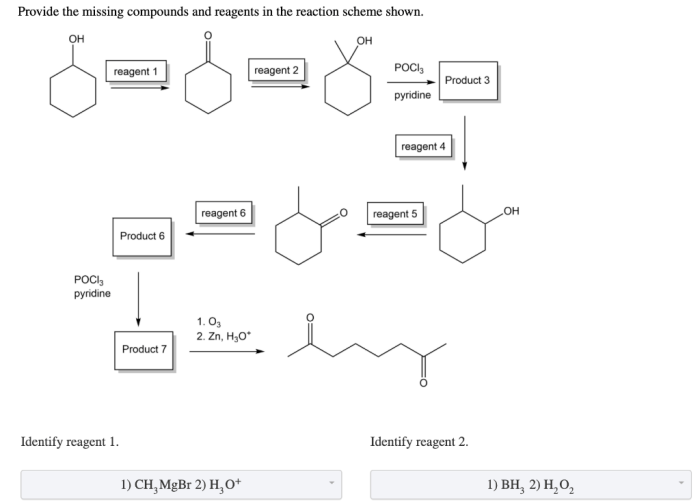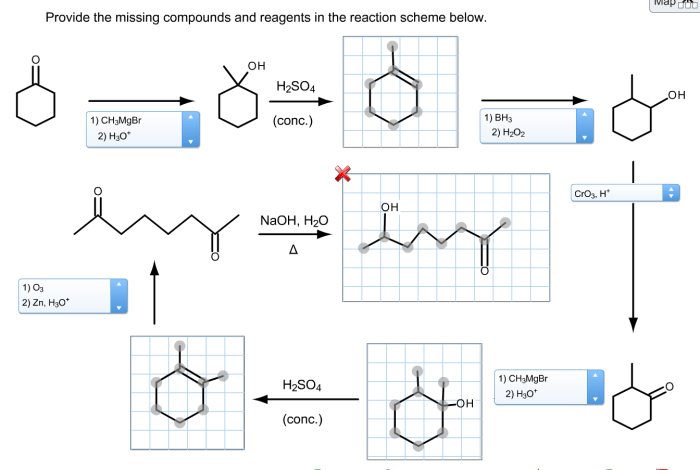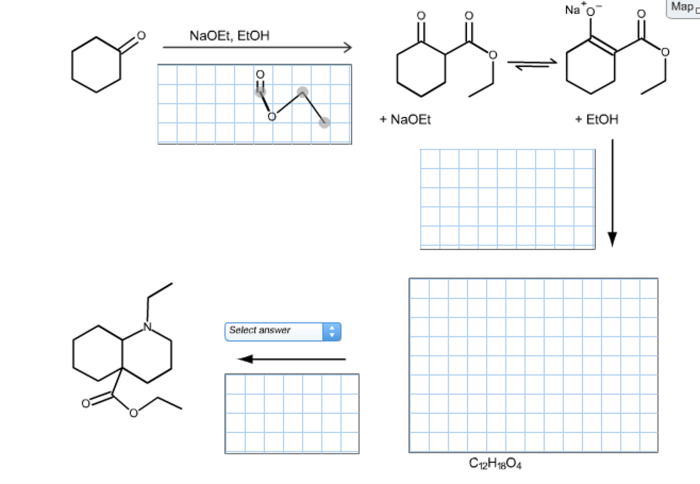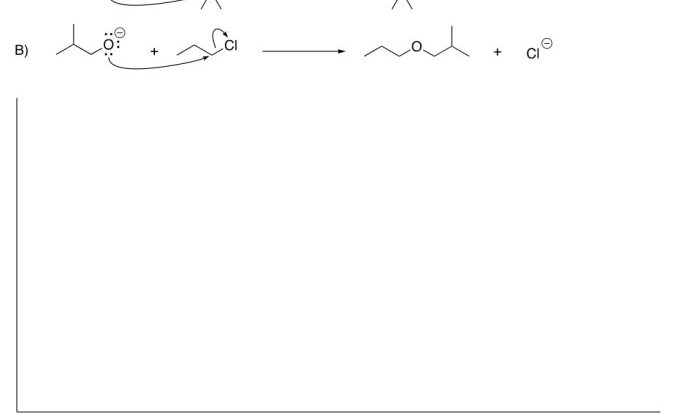Provide the missing compounds and reagents in the reaction scheme – In the realm of chemistry, reaction schemes serve as invaluable tools for depicting the intricate dance of chemical transformations. However, these schemes are often incomplete, lacking crucial compounds and reagents that are essential for understanding the underlying mechanisms. This article delves into the significance of providing missing compounds and reagents in reaction schemes, equipping readers with the knowledge and strategies to fill these gaps and unravel the complexities of chemical reactions.
By providing missing compounds, we illuminate the identities of the substances that participate in a reaction but are not explicitly stated. Similarly, identifying missing reagents reveals the agents that facilitate the transformation, enabling a comprehensive understanding of the reaction’s driving forces.
This knowledge empowers chemists to predict reaction outcomes, optimize synthetic pathways, and gain deeper insights into chemical processes.
Provide the Missing Compounds and Reagents in a Reaction Scheme

Providing missing compounds and reagents in a reaction scheme is a crucial aspect of accurately representing a chemical reaction. It enables researchers to understand the complete picture of the transformation and aids in the analysis and interpretation of experimental results.
1. Provide the Missing Compounds
Identifying missing compounds in a reaction scheme involves examining the reactants, products, and the known steps of the reaction. Missing compounds can be:
- Intermediates: Transient species that are formed and consumed during the reaction.
- Catalysts: Substances that facilitate the reaction without being consumed.
- Byproducts: Unintended products that are formed in addition to the desired product.
Methods for identifying missing compounds include:
- Mechanistic analysis: Understanding the reaction mechanism can reveal potential intermediates or side reactions.
- Spectroscopic techniques: NMR, IR, and mass spectrometry can provide insights into the identity of unknown compounds.
2. Provide the Missing Reagents
Missing reagents are crucial for understanding the conditions necessary for the reaction to occur. They can include:
- Oxidizing or reducing agents
- Bases or acids
- Solvents or catalysts
Strategies for identifying missing reagents include:
- Literature search: Consulting scientific literature and databases can provide information on typical reagents used in similar reactions.
- Reaction optimization: Experimentally varying reaction conditions can help identify the optimal reagents and their concentrations.
3. Design an HTML Table for Reaction Scheme Analysis, Provide the missing compounds and reagents in the reaction scheme
An HTML table can be used to organize and present information about a reaction scheme, including missing compounds and reagents.
| Reactants | Products | Missing Compounds | Missing Reagents |
|---|---|---|---|
| A, B | C, D | E (intermediate) | NaOH (base) |
4. Illustrate the Reaction Scheme with Missing Compounds and Reagents
Visualizing the reaction scheme with missing compounds and reagents highlighted can aid in understanding the overall transformation.

In this scheme, the missing intermediate E and the missing base NaOH are highlighted in red.
Answers to Common Questions: Provide The Missing Compounds And Reagents In The Reaction Scheme
What is the purpose of providing missing compounds in a reaction scheme?
Providing missing compounds helps identify the substances involved in a reaction that are not explicitly stated, providing a more complete picture of the reaction.
Why is it important to identify missing reagents in a reaction scheme?
Identifying missing reagents reveals the agents responsible for facilitating the reaction, allowing for a comprehensive understanding of the reaction’s driving forces.
What methods can be used to identify missing compounds and reagents?
Various methods can be employed, including analyzing reaction stoichiometry, considering the reaction mechanism, and consulting reference materials.



